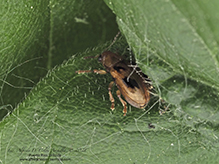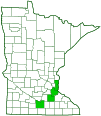strawberry rootworm
(Paria fragariae)
Conservation • Description • Habitat • Ecology • Distribution • Taxonomy
Conservation Status |
|
|||||||
| IUCN Red List | not listed |
|||||||
| NatureServe | NNR - Unranked |
|||||||
| Minnesota | not listed |
|||||||
Description |
||
Strawberry rootworm is a small leaf beetle. It occurs in the United States east of the Great Plains. There are two subspecies of strawberry rootworm. The ranges of each subspecies have not been clearly defined, but Paria fragariae kirki has been reported only in Alabama, while Paria fragariae fragariae has been reported in the north and in Alabama. The larvae are called rootworms. They live in the soil and feed on the roots of plants in the Rose (Rosaceae) family. In Minnesota, these include apple, blackberry, mountain ash, raspberry, rose, and strawberry. Adults are active from mid-July through fall. They feed on the leaves of the same plants. They have been reported on several other plants, including butternut, grape, hickory, oats, rye, soybean, and walnut, but these are now believed to be incidental occurrences, not true hosts. Strawberry rootworm is a minor pest of commercial strawberry crops. Both larvae and adults contribute to reduced vigor of the plants. But they seldom damage fruit, and they rarely occur in numbers large enough to be a serious problem. Adults are 1⁄16″ to ⅛″ (2.5 to 3.8 mm) long and 1⁄32″ to 1⁄16″ (1.3 to 2.2 mm) wide. The body is moderately robust, shiny, oval when viewed from above, convex when viewed from the side. The coloration is variable and has led to confusion with other species. It varies from light reddish brown (pale) with black markings to almost entirely black. The head is small and is inserted deeply into the first segment of the thorax (prothorax). It is only partially visible from above. The mouthparts are directed downward. The antennae have 11 segments. There is a distinct groove on the front between the forehead (frons) and the plate on the face (clypeus). The plate covering the prothorax (pronotum) is triangular. It is broadly rounded in front and is narrower in the rear than the hardened wing covers (elytra). The front margin is curved under in the middle but not on the sides. This forms a lobe on each side behind each compound eye. The sides of the pronotum are narrowly but distinctly thickened (beaded). The surface of the pronotum is finely wrinkled and slightly dotted with pits (punctate). It varies from pale with a black spot at the rear to almost entirely black. The elytra are long, concealing the entire abdomen. They are somewhat parallel on the sides. The outer margins are beaded and have a turned-under edge (epipleuron). The surface is hairless and very shallowly grooved with a row of punctures in each groove. Each elytron is usually pale with three black spots: a medium-sized spot in the shoulder (humeral) area that reaches the base; a small spot below that on the outer margin; and a large spot on the lower half. The spots are clearly separated from each other, and they do not merge with the spots on the opposite elytron. The legs are pale. There is a small tooth on the third segment (femur) of the front and hind legs. The last part of the leg (tarsus) has 5 segments, but the fourth segment is very small and is concealed within the lobes at the end of the third segment, making it appear to have just 4 segments. There are two claws at the end of the tarsus. Each claw is cleft at the end (bifid). On Paria fragariae fragariae, the elytra are highest at two-thirds from the base. The sides are convex. The bead is distinct all the way to the tip. The dark areas are not especially shiny. The tooth on the femur is present but sometimes indistinct, especially on the front legs. On Paria fragariae kirki, the elytra are somewhat flattened, not highest at two-thirds from the base. They are often almost entirely black. The sides are nearly parallel. The bead becomes rounded and indistinct behind the middle. The dark areas are very shiny. The tooth on the femur is distinct on both the front and the hind legs. |
||
Size |
||
Total length: 1⁄16″ to ⅛″ (2.5 to 3.8 mm) |
||
Similar Species |
||
Habitat |
||
|
||
Ecology |
||
Season |
||
One generation per year: mid-July through fall |
||
Behavior |
||
Adults are active at night and are not usually seen during the day. |
||
Life Cycle |
||
Adults overwinter in the soil or in leaf litter on the ground. They become active and lay eggs in mid- to late spring. Mature larvae pupate in the soil and emerge as adults between mid-July and August. |
||
Larva Food |
||
Roots of plants in the Rose (Rosaceae) family, including apple, blackberry, mountain ash, raspberry, rose, and strawberry |
||
Adult Food |
||
Leaves of plants in the Rose (Rosaceae) family, including apple, blackberry, mountain ash, raspberry, rose, and strawberry |
||
Distribution |
||||
|
Sources |
|||
| 1/15/2023 | ||||
Occurrence |
||||
|
||||
Taxonomy |
|||
Order |
Coleoptera (Beetles) | ||
Suborder |
Polyphaga (Water, Rove, Scarab, Long-horned, Leaf, and Snout Beetles) | ||
Infraorder |
Cucujiformia | ||
Superfamily |
Chrysomeloidea (leaf beetles and allies) | ||
Family |
Chrysomelidae (leaf beetles) | ||
Subfamily |
Eumolpinae (oval leaf beetles) | ||
Tribe |
Typophorini | ||
Genus |
Paria | ||
Subordinate Taxa |
|||
strawberry rootworm (Paria fragariae fragariae) strawberry rootworm (Paria fragariae kirki) |
|||
Paria fragariae fragariae was for a long time referred to as cinnamon oval leaf beetle (Paria fragariae) or four-marked oval leaf beetle (Paria quadrinotata). It is now recognized as a subspecies of strawberry rootworm (Paria fragariae). |
|||
Synonyms |
|||
|
|||
Common Names |
|||
strawberry rootworm |
|||
Glossary
Clypeus
On insects, a hardened plate on the face above the upper lip (labrum).
Elytra
The hardened or leathery forewings of beetles used to protect the fragile hindwings, which are used for flying. Singular: elytron.
Epipleuron
On beetles: The prominent, turned down or turned under, lateral edge of an elytron. Plural: epipleura.
Femur
On insects and arachnids, the third, largest, most robust segment of the leg, coming immediately before the tibia. On humans, the thigh bone.
Frons
The upper front part of an insect’s face, roughly corresponding to the forehead.
Pronotum
The exoskeletal plate on the upper side of the first segment of the thorax of an insect.
Prothorax
The first (forward) segment of the thorax on an insect, bearing the first pair of legs but not wings.
Punctate
Dotted with pits (punctures), translucent sunken glands, or colored spots of pigment.
Tarsus
On insects, the last two to five subdivisions of the leg, attached to the tibia; the foot. On spiders, the last segment of the leg. Plural: tarsi.
Visitor Photos |
|||||
Share your photo of this insect. |
|||||
| This button not working for you? Simply email us at info@MinnesotaSeasons.com. Attach one or more photos and, if you like, a caption. |
|||||
Alfredo Colon |
|||||
 |
|||||
MinnesotaSeasons.com Photos |
|||||
|
|||||

Slideshows |
||

Visitor Videos |
|||
Share your video of this insect. |
|||
| This button not working for you? Simply email us at info@MinnesotaSeasons.com. Attach a video, a YouTube link, or a cloud storage link. |
|||
Other Videos |
|||

Created: 1/18/2024
Last Updated:


